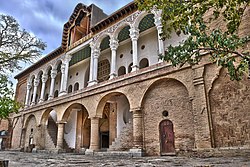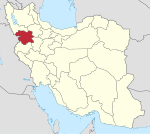world.wikisort.org - Iran
Sanandaj (Persian: سنندج, pronounced [sænænˈdædʒ] (![]() listen); Kurdish: سنە, romanized: Sine, often romanized as Senneh,[3] is the capital of Kurdistan Province in Iran. With a population of 414,069,[4] Sanandaj is the twenty third largest city in Iran and the second largest Kurdish city. Sanandaj's founding is fairly recent, (about 250 years ago), yet under its short existence it has grown to become one of the centers of Kurdish culture.[5][6] During the Iraq-Iran War the city was attacked by Iraqi planes and saw disturbances.[7] From 2019 UNESCO has recognized Sineh (Sanandaj) as Creative City of Music.[8] The city is located between the Qishlaq river, a tributary of the Diyala, and Mount Awidar, which separates it from the old Ardalan capital of Hasanabad.[9] Carpet making is the biggest industry in Sanandaj.[9]
listen); Kurdish: سنە, romanized: Sine, often romanized as Senneh,[3] is the capital of Kurdistan Province in Iran. With a population of 414,069,[4] Sanandaj is the twenty third largest city in Iran and the second largest Kurdish city. Sanandaj's founding is fairly recent, (about 250 years ago), yet under its short existence it has grown to become one of the centers of Kurdish culture.[5][6] During the Iraq-Iran War the city was attacked by Iraqi planes and saw disturbances.[7] From 2019 UNESCO has recognized Sineh (Sanandaj) as Creative City of Music.[8] The city is located between the Qishlaq river, a tributary of the Diyala, and Mount Awidar, which separates it from the old Ardalan capital of Hasanabad.[9] Carpet making is the biggest industry in Sanandaj.[9]
Sanandaj
سنە / Sine (Kurdish) | |
|---|---|
City | |
Sanandaj from Abidar, Sanandaj Museum, Khosro Abad Mansion, Qeshlaq Bridge | |
 Seal | |
 Sanandaj | |
| Coordinates: 35°18′52″N 46°59′32″E | |
| Country | Iran |
| Province | Kurdistan |
| County | Sanandaj |
| Bakhsh | Central |
| Government | |
| • Mayor | Seyed Anwar Rashidi[1] |
| Area | |
| • City | 3,033 km2 (1,171 sq mi) |
| Elevation | 1,538 m (5,046 ft) |
| Population (2016 Census) | |
| • Urban | 412,767 [2] |
| Time zone | UTC+3:30 (IRST) |
| • Summer (DST) | UTC+4:30 (IRDT) |
| Area code | 087 |
| Climate | Csa |
| Website | e-sanandaj |
History
The name "Sinna" first appears in records from the 14th century CE.[10] Before this, the main city in the region was Sisar, whose exact location is unknown.[10] Sisar was also called "Sisar of Sadkhaniya", or "Sisar of the hundred springs", and it has been proposed that the current name of "Sinna" is a contracted form of "Sadkhaniya".[10]
The name "Sisar" disappears in the 14th century and the name "Sinna" replaces it, for example in the works of Hamdallah Mustawfi who refers to a mountain and a pass with this name.[10] Then the Kurdish historian Sharaf al-Din Bitlisi mentions that in 1580 an Ardalan ruler named Timur Khan had a land grant including Sinna and the earlier Ardalan capital of Hasanabad.[9] However, the local historian Ali-Akbar Munshi Waqayi-Nigar wrote in 1892/3 that Sinna was founded later, by the ruler Soleyman Khan Ardalan, on the site of an earlier settlement; the chronogram he gives for this event corresponds to 1046 AH, or 1636-7 CE.[9] Sinna was developed significantly under the reign of Aman Allah "the Great" (from 1797-1825).[9] 19th-century Sinna was "a lively commercial center, exporting oak galls, tragacanth, furs, and carpets".[9] Its population was mostly Kurdish, with a significant Jewish minority and smaller numbers of Armenian and Chaldean Catholic Christians.[9]
People
The population of Sanandaj is mainly Kurdish. The city also had an Armenian minority who gradually emigrated from the city. Until the Iranian Revolution (1979), the city had a small Aramaic-speaking Jewish community of about 4,000 people.[5] The city boasted a sizable Assyrian community that spoke a unique dialect of Aramaic called Senaya, they are mostly members of the Chaldean Catholic Church.[11] The economy of Sanandaj is based upon the production of carpets, processed hides and skins, milled rice, refined sugar, woodworking, cotton weaving, metalware and cutlery.[12][13]
Most of the people of Sanandaj follow the Shafi‘i branch of Sunni Islam.[14][15]
Language
The linguistic composition of the city:[16]
Climate

Sanandaj has a humid continental climate (Dsa) according to the Köppen climate classification with cold and wet winters and hot and dry summers.
References
- "سید انور رشیدی شهردار سنندج". IRNA. Retrieved 27 September 2021.
{{cite web}}: CS1 maint: url-status (link) - "Statistical Center of Iran > Home".
- Senneh rug
- "آمار جمعیتی شهرستان سنندج :: فرمانداری سنندج".
- Geoffrey Khan, The Jewish Neo-Aramaic Dialect of Sanandaj, Piscataway NJ: Gorgias Press, p. 1.
- Sanandaj Encyclopædia Britannica, retrieved 16 July 2014.
- "Sanandaj | Iran | Britannica".
- "Sanandaj one-year anniversary as a UNESCO Creative City of Music | Creative Cities Network". en.unesco.org. Archived from the original on 7 December 2020.
- Minorsky, Vladimir (1997). "SANANDADJ". In Bosworth, C.E.; van Donzel, E.; Heinrichs, W.P.; Lecomte, G. (eds.). The Encyclopaedia of Islam, Vol. IX (SAN-SZE) (PDF). Leiden: Brill. pp. 6–7. ISBN 90-04-10422-4. Retrieved 13 June 2022.
- Minorsky, Vladimir (1997). "SĪSAR". In Bosworth, C.E.; van Donzel, E.; Heinrichs, W.P.; Lecomte, G. (eds.). The Encyclopaedia of Islam, Vol. IX (SAN-SZE) (PDF). Leiden: Brill. pp. 680–1. ISBN 90-04-10422-4. Retrieved 13 June 2022.
- Khan, Geoffrey (2009). The Jewish Neo-Aramaic Dialect of Sanandaj. Gorgias Press. pp. 3–4. ISBN 978-1-60724-134-8.
- "کردستان از نظر نرخ بیکاری در جایگاه دوم کشور قرار گرفت". yjc.ir. Retrieved 14 May 2016.
- "سرمایهگذاری در صنعت و معدن کردستان، 4 برابر کمتر از متوسط کشوری است". sanayenews.com. Retrieved 14 May 2016.
- "Intelligence Ministry "Invites" Rouhani Campaign Manager to Stop Advocating for Sunni Muslim Rights". 17 November 2017.
- BC.Diakonoff, I. M. (1985), "Media", The Cambridge History of Iran, 2 (Edited by Ilya Gershevitch ed.), Cambridge, England: Cambridge University Press, ISBN 978-0-521-20091-2
- "Language distribution: Kordestan Province". Iran Atlas. Retrieved 25 September 2021.
{{cite web}}: CS1 maint: url-status (link)
Sources
- Yamaguchi, Akihiko (2021). "The Kurdish frontier under the Safavids". In Matthee, Rudi (ed.). The Safavid World. Routledge. pp. 556–571.
External links
На других языках
[de] Sanandadsch
Sanandadsch (persisch سنندج, DMG Sanandaǧ; auch Sanandaj; kurdisch .mw-parser-output .Arab a,.mw-parser-output a bdi.Arab{text-decoration:none!important}.mw-parser-output .Arab{font-size:120%}سنە, Sine) ist die Hauptstadt der iranischen Provinz Kordestān nahe der Grenze zum Irak. Die Stadt ist 512 km von der Landeshauptstadt Teheran entfernt und liegt in einer Höhe von 1480 m. Die Stadt ist die größte kurdische Stadt im Iran und ein Zentrum der iranisch-kurdischen Kultur.[2]- [en] Sanandaj
[ru] Сенендедж
Сененде́дж (перс. سنندج, от курдск. Sine Dizh — «Замок Сены», курд. Sine, سنە) — город на западе Ирана, административный центр провинции Курдистан.Другой контент может иметь иную лицензию. Перед использованием материалов сайта WikiSort.org внимательно изучите правила лицензирования конкретных элементов наполнения сайта.
WikiSort.org - проект по пересортировке и дополнению контента Википедии




